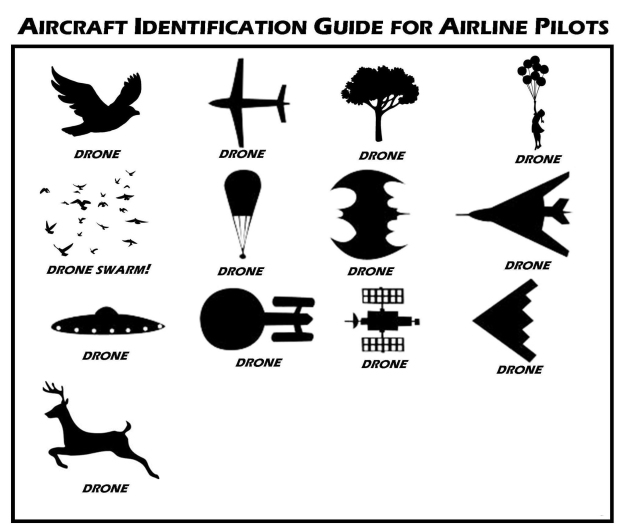Drone near miss 'down to providence'
OK, seems sensible so far...could be a drone... Lets read further:-
Right OK, so its a 1 metre by half a metre "drone" cruising along at 6,000ft AGL. Yeah plausible. But as per usual the Airprox board and CAA trot out soundbites without ever seriously questioning the report or what the object is. That size and flight envelope is so far out of the reach of "drones" its pretty much impossible yet the claim is allowed to stand.
This sums up the problem - drones get a bad press and some really are operated by idiots that help earn that bad reputation. But more and more now every single incident is blamed on a drone without any actual verification or checking of facts thereby making even more bad press.
So, what drone is blue, a metre long, half a metre wide and can routinely cruise at 6,000ft?!
Heres another one:- Drone 'narrowly avoids' plane collision
6,000ft again. and ATC warned of another aircraft passing overhead. There is no way a drone is going to appear on primary radar to that extent or be operating up there yet its classed as a drone near miss without question.
...and another:- Drone 'endangered' plane above school
A mid-air crash between a plane and a drone was only avoided by "providence", an air safety report has said.
The drone missed the wing tip of a Cessna light aircraft by 6-8ft (2-2.5m) as it was flying over Northumberland.
The UK Airprox Board said the drone had been flown "beyond practical VLOS [visual line of sight] limits and was endangering other aircraft".
OK, seems sensible so far...could be a drone... Lets read further:-
The pilot had been flying at 6,000ft (1,800m) over Bolam Lake Country Park in July.
He reported being "startled" by a "large blue object slightly to the left of his aircraft's nose at exactly the same level", the report said.
.
.
"Although the incident only lasted five to six seconds he estimates that the drone was one metre in length and half a metre wide.
Right OK, so its a 1 metre by half a metre "drone" cruising along at 6,000ft AGL. Yeah plausible. But as per usual the Airprox board and CAA trot out soundbites without ever seriously questioning the report or what the object is. That size and flight envelope is so far out of the reach of "drones" its pretty much impossible yet the claim is allowed to stand.
This sums up the problem - drones get a bad press and some really are operated by idiots that help earn that bad reputation. But more and more now every single incident is blamed on a drone without any actual verification or checking of facts thereby making even more bad press.
Or more accurately, it took him a few seconds to convince himself it was a drone despite not having a clue initially.It took him a few seconds to realise it was a drone.
So, what drone is blue, a metre long, half a metre wide and can routinely cruise at 6,000ft?!
Heres another one:- Drone 'narrowly avoids' plane collision
6,000ft again. and ATC warned of another aircraft passing overhead. There is no way a drone is going to appear on primary radar to that extent or be operating up there yet its classed as a drone near miss without question.
...and another:- Drone 'endangered' plane above school
Thats utterly amazing eyesight to be able to spot and clearly identify a drone 1600ft away!The DH8 was 150m (500ft) over the school near Birmingham Airport last September when the pilot saw the drone about 500m (1,640ft) away.
Last edited:











